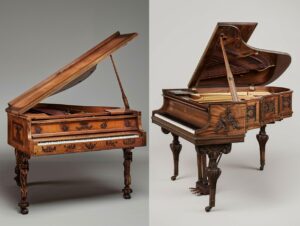Are you in the market for a new piano but unsure whether to choose a baby grand or grand piano?
This article will provide an in-depth comparison of the two types of pianos, covering everything from size and design differences to sound quality and cost considerations.
We will also discuss how space limitations can impact your decision and compare the playing experience of each type of piano.
Whether you’re a seasoned pianist or a beginner, this article will help you make an informed choice when it comes to selecting the right piano for your needs.
| Aspect |
Baby Grand Piano |
Grand Piano |
| Size |
Smaller, typically 4’6″ to 5’10” |
Larger, typically 5’10” to over 9′ |
| Sound Quality |
High quality but more limited in depth |
Richer and fuller due to longer strings |
| Space Suitability |
Better for smaller spaces |
Requires more space, better for larger areas |
| Usage Preference |
Preferred for personal use in households |
Preferred for professional performances |
| Sound Projection |
Less robust but sufficient for smaller spaces |
More powerful, ideal for concert settings |
| Ease of Playing |
More compact, easier for beginners |
Larger, may offer a more nuanced experience |
| Cost |
Generally less expensive |
Generally more expensive |
| Maintenance |
Regular maintenance required, similar to grand pianos |
May require more frequent tuning due to complex design |
| Aesthetics |
Elegant, fits well in intimate environments |
Majestic, grandiose presence in large spaces |
| Common Use |
Domestic, studios |
Concert halls, performance venues |
| Price Range |
Several thousand dollars |
Tens of thousands to hundreds of thousands of dollars |
| Resonance and Tonal Purity |
Good, but less than grand pianos |
Superior resonance and tonal purity |
| Craftsmanship and Longevity |
High quality, durable |
Exceptional craftsmanship, highly durable |
Types of Pianos
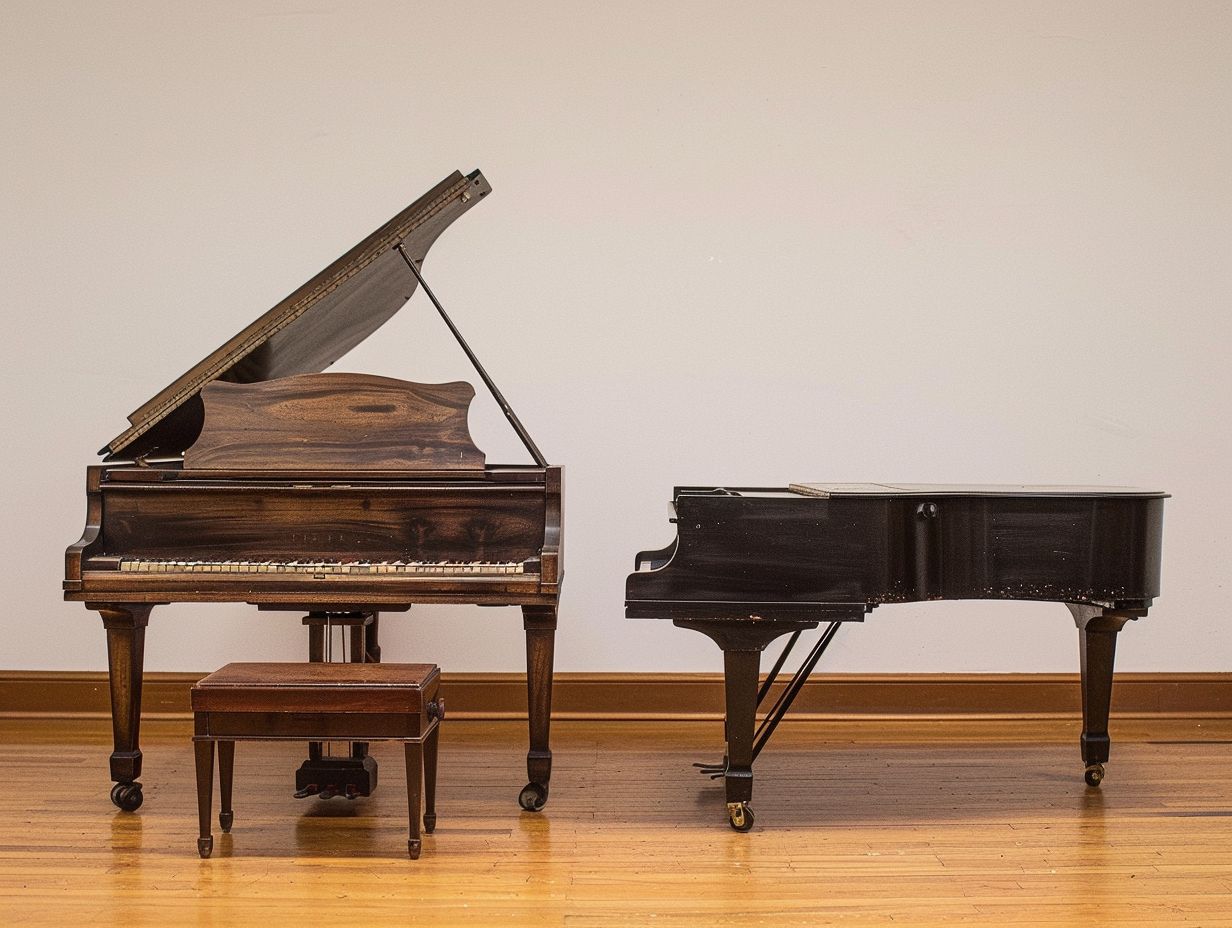
In the realm of pianos, a variety of types exist, each possessing distinct characteristics and qualities. Notable among these are grand pianos, baby grand pianos, concert grand pianos, and professional grand pianos.
Grand pianos are renowned for their expansive size and exceptional sound projection, rendering them well-suited for deployment in concert halls and performance venues. Conversely, baby grand pianos, while more modest in size, are designed to fit snugly within smaller spaces while still offering a premium tonal quality.
Exceeding standard grand pianos in scale, concert grand pianos are distinguished by their unmatched resonance and tonal purity, making them the instrument of choice for professional musicians and prestigious events. Professional grand pianos amalgamate the superlative attributes of concert grands with precise mechanisms tailored for advanced players seeking nothing less than uncompromised performance quality.
Overview of Baby Grand and Grand Pianos
Both baby grand pianos and grand pianos are considered exquisite musical instruments renowned for their exceptional piano sound quality attributed to the lengthier strings they possess.
While baby grand pianos are typically smaller in size, making them suitable for more compact spaces, grand pianos are larger and produce richer, more resonant tones as a result of their longer strings. The extended strings in grand pianos enable a broader range of sound dynamics and depth, surpassing what can be achieved with baby grand pianos. Grand pianos are often the preferred choice for professional performances and concert hall settings because of their robust and nuanced sound projection capabilities. Conversely, baby grand pianos are favored for personal use in households and are commonly selected due to their space-saving design.
Size and Design Differences
The diversity among pianos can be primarily observed in their size and design, encompassing a range of options from smaller grand pianos to larger concert grands, each meticulously crafted to specific size specifications.
Smaller grand pianos typically span from approximately 5 to 7 feet in length, rendering them a favored choice for home usage owing to their modest dimensions. On the contrary, large concert grands can surpass 9 feet in length, providing a resonant and robust sound that resonates throughout concert halls with grandiosity. The dimensional prerequisites for concert grands are essential to deliver the complete spectrum of tones required in expansive performance venues, whereas smaller grand pianos offer greater versatility in adapting to diverse spaces without compromising on sound quality.
Dimensions and Aesthetics
The variations in dimensions and aesthetics among pianos are extensive, ranging from the refined appearance of smaller grand pianos to the grandiose nature of concert grands, presenting a diverse array of choices to accommodate various preferences.
Smaller grand pianos, characterized by their modest size and elegant contours, are often preferred for compact spaces or intimate environments. Their streamlined design can introduce an element of refinement to any setting, rendering them popular selections for residences and studios.
Conversely, larger concert grands make a commanding impression due to their substantial dimensions and majestic presence. The intricate ornamentation and superb artisanship of these instruments enhance their allure as focal points in concert halls and grand establishments.
Sound Quality Comparison
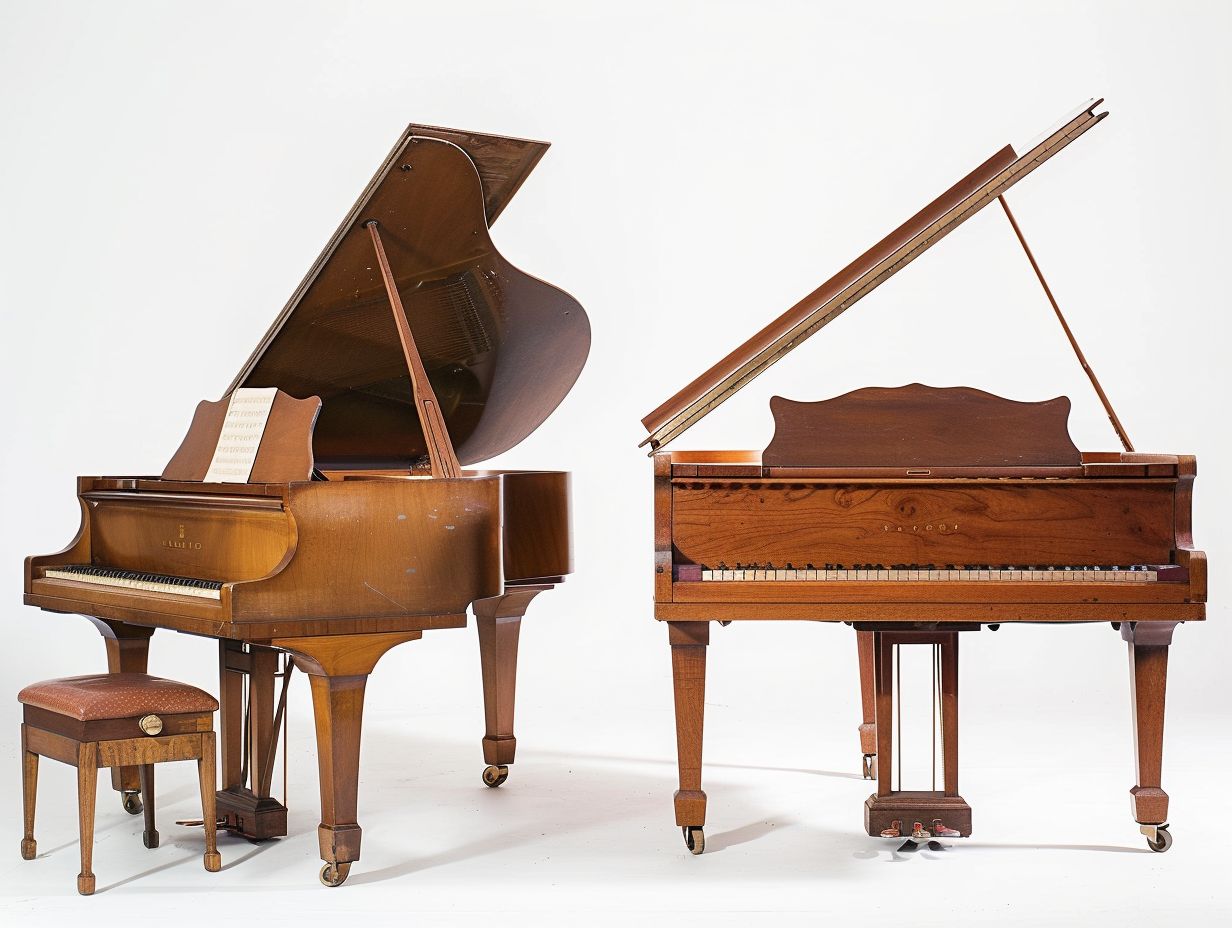
In the realm of pianos, sound quality stands as a paramount consideration, where elements such as piano sound, loudness, richness, and string vibration collectively contribute to the overarching acoustic experience.
The sound emitted by a piano emerges from intricate interactions among the strings, hammers, soundboard, and additional components. This sound resonates throughout the piano, giving rise to a distinctive amalgamation of frequencies that discern its tonal attributes.
In considerations of loudness, pianos can exhibit varying projection capabilities, some yielding a more resonant sound than others. Richness in piano sound denotes the profundity and intricacy of the tones generated, a facet influenced by factors such as material quality and artisanal craftsmanship. String vibration assumes a pivotal role in shaping the overall sound quality, directly impacting the clarity and sustain of notes.
Factors Affecting Sound
Numerous factors contribute to the acoustics of a piano, encompassing the length of its strings, string characteristics, acoustic properties, and the overall craftsmanship of the instrument.
The length of the strings within a piano plays a critical role in dictating its sound production. This length directly influences the tone and resonance of the notes emitted, with longer strings yielding a more robust and resonant sound profile due to heightened string vibrations.
Variances in string lengths between distinct sections of the piano, such as the bass and treble regions, are pivotal in shaping the instrument’s comprehensive tonal character. These discrepancies give rise to a diverse spectrum of sound that imbues musical interpretations with depth and complexity. When combined with superior-quality materials and expert artistry, extended strings serve to augment the acoustic attributes of the piano, guaranteeing exceptional sound quality.
Cost Comparison
When evaluating pianos, conducting a thorough cost comparison is crucial. Various factors, including the presence of local dealers, reputable manufacturers, the quality of grand pianos, and adherence to industry standards, all play a significant role in determining pricing.
Local dealers hold a pivotal position in the pricing structure of pianos due to their proximity to customers and the personalized service they provide. Renowned manufacturers, recognized for their exceptional craftsmanship and meticulous attention to detail, often command higher prices for their instruments. The inherent value of high-quality grand pianos is undeniable, given their superior construction and exceptional sound quality, both of which contribute to their premium pricing. Adherence to industry best practices, such as transparent pricing policies and ethical sales strategies, serves to ensure that customers receive equitable transactions when investing in a piano.
Price Range and Value for Money
From a professional perspective, the evaluation of the price range and value for money of pianos entails the comprehensive assessment of factors such as exceptional quality, distinctive advantages, and the longevity associated with grand pianos. Grand pianos are acclaimed for their remarkable craftsmanship and construction, attributes that significantly contribute to their durability and enduring value. Opting for a grand piano not only guarantees an elevated musical experience but also presents itself as a timeless piece of art suitable for any environment.
Despite grand pianos having a higher initial cost relative to other piano types, their enduring quality and performance render them a worthwhile investment for both musicians and enthusiasts. The distinctive merits of grand pianos, including superior sound quality and enhanced resonance, distinguish them as instruments of unparalleled musical expression.
Space Considerations
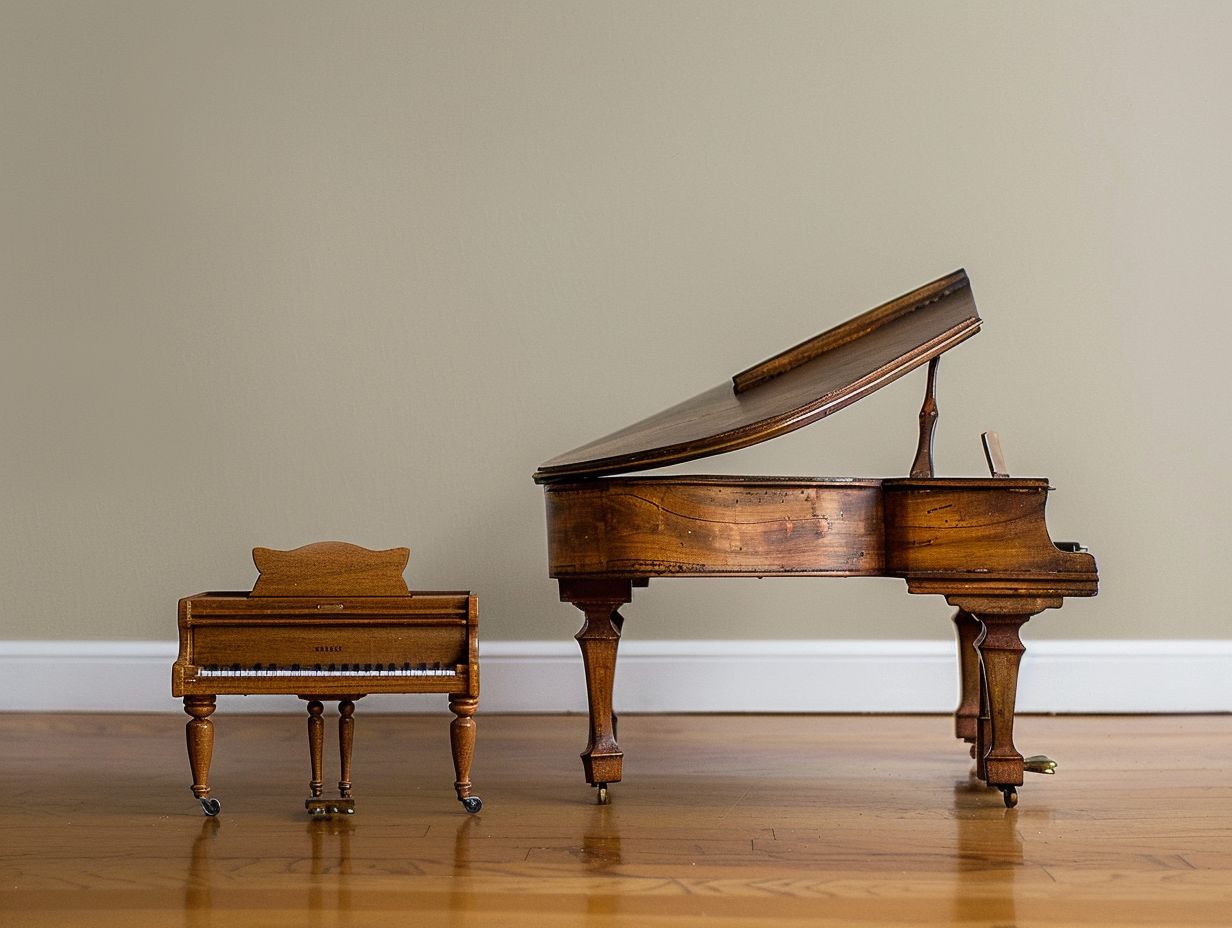
When selecting a piano, space considerations are of utmost importance, particularly when weighing the options between a baby grand piano and a grand piano, each presenting distinct advantages concerning size and performance.
The dimensions of a piano can significantly influence its integration into a room and impact its overall visual appeal. A baby grand piano, typically measuring around 5 feet in length, is a favored option for individuals with spatial constraints yet desiring a top-tier instrument.
Conversely, grand pianos, spanning from 6 to 9 feet, are renowned for their impressive sound projection and resonance. In terms of performance, grand pianos provide a broader spectrum of tones and dynamics when compared to baby grands. The choice between a baby grand piano and a grand piano ultimately hinges on personal preferences and the available space within one’s residence.
Determining the Right Size for Your Space
Determining the appropriate size for your space entails carefully evaluating the options between a baby grand piano and other grand pianos to ascertain the most suitable match for your requirements and available area.
When faced with the decision between a baby grand piano and other grand pianos, it is imperative to consider the dimensions of your room to ensure the instrument integrates seamlessly without dominating the space. Baby grand pianos are often preferred for smaller rooms due to their compact design, rendering them a popular choice for residential environments.
Conversely, larger grand pianos, such as concert grands, are well-suited for expansive areas and professional performances where their resonant sound can effortlessly fill the room. Variables such as acoustics, aesthetics, and frequency of use should also be factored in prior to finalizing your selection.
Playing Experience Comparison
For musicians, the experience of playing on various pianos can be significantly influenced by factors such as ease of playability, string vibration, the pursuit of an ideal piano, and the prevalent presence of baby grand pianos within the industry.
The ease of playability can have a profound impact on a pianist’s overall enjoyment and performance. Certain pianos offer a smooth and responsive touch, making it effortless for musicians to execute intricate passages. Additionally, the effects of string vibration produced by different pianos can enhance the richness and depth of the sound, thereby enriching the overall musical experience.
Pianists are consistently in search of the perfect piano that aligns with their unique style and preferences. Baby grand pianos, renowned for their versatility and elegance, have emerged as a popular choice among musicians for both professional performances and domestic settings.
Ease of Playing and Sound Projection
Each piano possesses unique qualities that influence playability and sound projection, making it crucial to compare different types such as grand pianos and baby grands from personal and professional perspectives.
The grand piano, characterized by its larger size and longer strings, typically delivers deeper and more resonant tones in comparison to the baby grand. Esteemed musicians often gravitate towards grand pianos due to their robust sound projection and expansive dynamic range, while some individuals may prefer the more compact dimensions and intimate ambiance of a baby grand for personal enjoyment.
The discerning ear of experienced players is attuned to the nuanced differences in tone production and timbre variations between these two piano types, allowing for a genuine appreciation of their distinct sound qualities.
Frequently Asked Questions
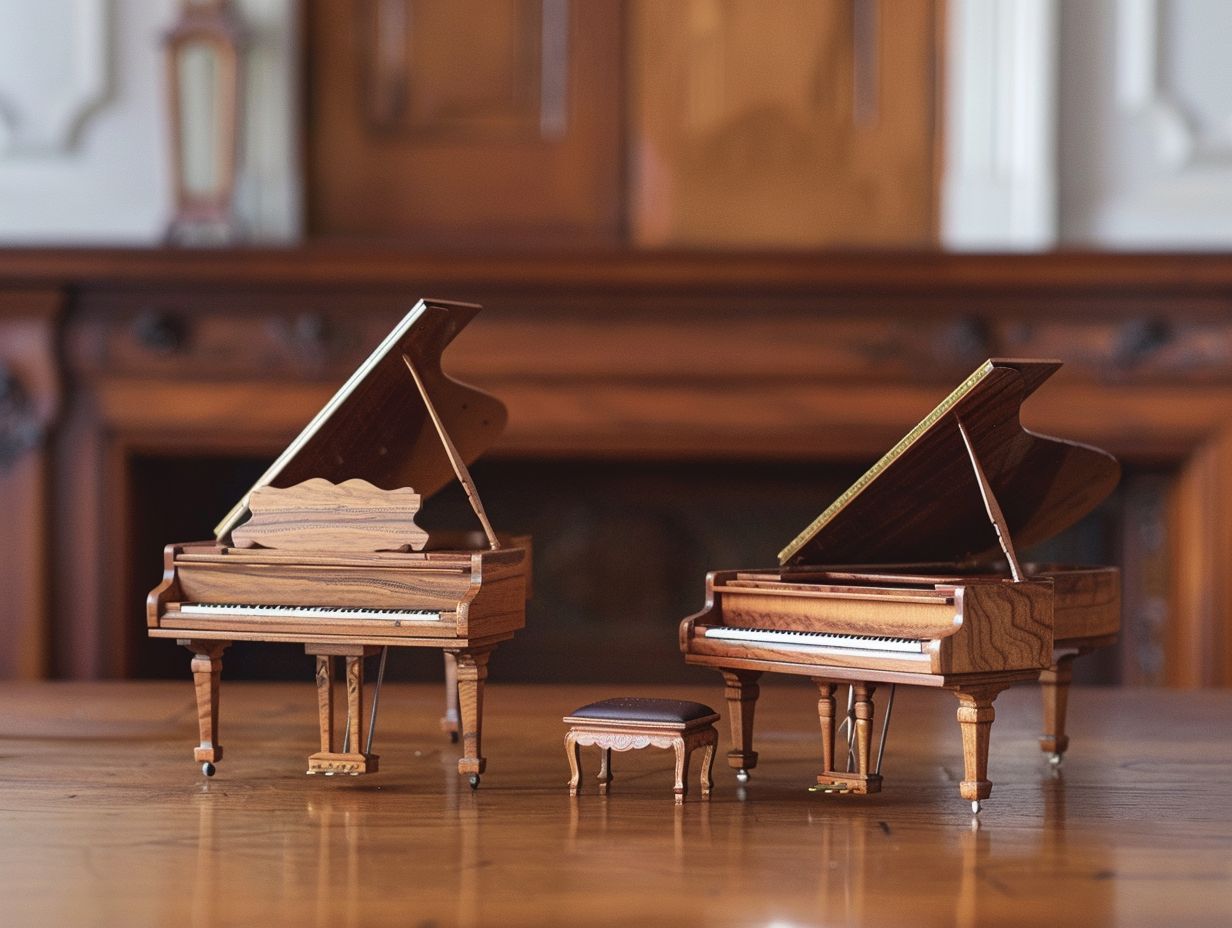
What is the difference between a baby grand and a grand piano?
A baby grand piano is smaller than a grand piano and typically ranges from 4 feet 6 inches to 5 feet 10 inches in length. A grand piano is larger and can range from 5 feet 10 inches to over 9 feet in length. The size difference affects the sound and overall performance of the instrument.
Which type of piano is better for a smaller space?
A baby grand piano is better suited for smaller spaces as it takes up less room. However, it is important to consider the acoustics of the room and the intended use of the piano when making this decision.
Do baby grand pianos have the same sound quality as grand pianos?
While both types of pianos have a similar sound, grand pianos typically have a richer and fuller tone due to their larger size. However, the sound quality can also depend on the specific make and model of the piano.
Are there any differences in terms of maintenance and care for baby grand and grand pianos?
Both types of pianos require regular maintenance and care, such as tuning and cleaning, to ensure they are in good working condition. However, grand pianos may require more frequent tuning due to their larger size and complex design.
Which type of piano is more suitable for beginners?
For beginners, a baby grand piano may be a better option as it is smaller and more affordable. However, it ultimately depends on the individual’s preferences and playing style.
Is there a significant price difference between a baby grand and a grand piano?
Yes, there is a noticeable price difference between the two types of pianos. Grand pianos can range from tens of thousands to hundreds of thousands of dollars, while baby grand pianos are generally less expensive but can still cost several thousand dollars.







